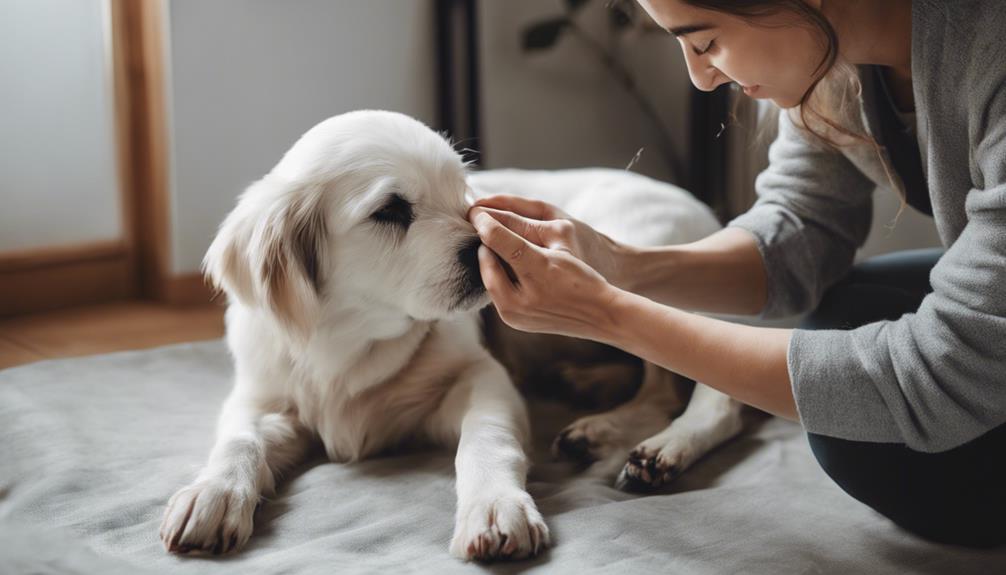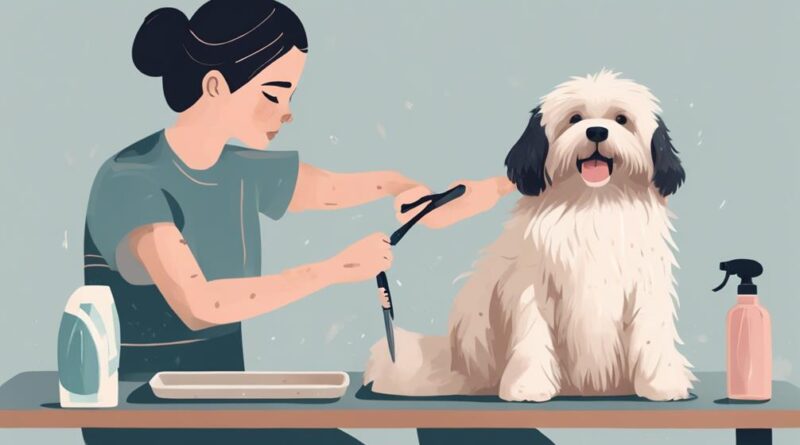How-To Guide: Essential Dog Grooming Techniques
You might think that grooming your dog is a daunting task, but with the right techniques, it can become a seamless part of your routine.
From brushing to nail trimming and everything in between, mastering essential grooming skills is crucial for your dog's well-being.
Understanding how to properly care for your furry friend's coat, ears, teeth, and paws can help prevent health issues and keep them looking their best.
So, let's explore these key grooming techniques that will make your pup feel pampered and healthy.
Brushing Techniques
When brushing your dog, make sure to use gentle strokes to untangle any knots or mats in their fur. Proper brushing is essential not only for keeping your dog looking neat but also for shedding prevention. Regular brushing helps distribute the natural oils in your dog's coat, keeping it healthy and shiny. It also stimulates the skin and removes dead hair, reducing the amount of loose fur around your home.
To start, choose the right brush for your dog's coat type. For short-haired breeds, a bristle brush works well, while long-haired breeds may require a slicker brush or a comb. Begin brushing in the direction of hair growth, focusing on one section at a time. Be gentle around sensitive areas like the belly, ears, and tail.
Make brushing a positive experience for your dog by rewarding them with treats and praise. Aim for short brushing sessions several times a week to maintain a healthy coat and minimize shedding. By incorporating proper brushing techniques into your routine, you can help your dog look and feel their best while keeping your home fur-free.
Bathing Tips
Proper bathing is another crucial aspect of maintaining your dog's hygiene and grooming routine. When it comes to bathing your furry friend, start by choosing a gentle shampoo specifically formulated for dogs to avoid skin irritation. Ensure the water temperature is lukewarm, as water that's too hot or too cold can make your pup uncomfortable.
During the bath, gently massage the shampoo into your dog's coat, being careful to avoid the eyes and ears. Once your dog is squeaky clean, it's time to dry them off. Use a soft towel to gently pat their fur dry, avoiding vigorous rubbing that can cause tangles and matting. If your dog has a thick coat, you may also consider using a blow dryer on a low, cool setting to help speed up the drying process.
Nail Trimming
Keeping your dog's nails trimmed is essential for their comfort and overall well-being. Proper technique is crucial to ensure a safe and effective nail trimming session. Start by using sharp, high-quality clippers designed specifically for dogs. Begin by gently holding your dog's paw, then trim the tip of each nail at a slight angle. Be cautious not to cut too close to the quick, which is a sensitive area containing blood vessels. If you accidentally cut the quick, styptic powder can help stop the bleeding.
Safety precautions are important during nail trimming to prevent any accidents or injuries. Make sure to have treats on hand to reward your dog for good behavior during the process. If your dog is anxious or uncooperative, consider seeking assistance from a professional groomer. Additionally, ensure you're in a well-lit area to clearly see your dog's nails and avoid cutting too short.
Ear Cleaning
To ensure your dog's hygiene and health, regular ear cleaning is a crucial aspect of grooming. Proper ear care can help prevent ear infections and treat ear mites effectively.
Here are some essential tips for cleaning your dog's ears:
- Regular Inspection: Check your dog's ears weekly for any signs of redness, swelling, or unusual discharge. Early detection can help prevent infections.
- Gentle Cleaning Solution: Use a veterinarian-recommended ear cleaning solution to clean your dog's ears. Avoid using cotton swabs, as they can push debris further into the ear canal.
- Gentle Massage: Gently massage the base of your dog's ears after applying the cleaning solution. This will help loosen any dirt or wax buildup.
- Consult Your Vet: If you notice any foul odor, persistent itching, or discharge, consult your vet immediately. These could be signs of an underlying ear infection that requires professional treatment.
Coat Clipping
Regularly trimming your dog's coat is essential for maintaining their overall health and appearance. When it comes to coat clipping, selecting the right blade is crucial. Different clipping styles, such as a puppy cut or a lion cut, require specific blade sizes. For instance, a shorter blade like a #10 is ideal for a close shave, while a #7 blade leaves the coat slightly longer. Understanding the clipping styles will help you achieve the desired look for your furry friend.
Establishing a maintenance schedule for coat clipping is important. Depending on your dog's breed and coat type, clipping may be needed every 4-8 weeks to prevent matting and maintain cleanliness. Before starting, ensure you have the necessary grooming tools, such as clippers, blades, scissors, and a slicker brush. Regularly cleaning and oiling your clippers will prolong their lifespan and ensure a smooth clipping experience. By following a consistent grooming routine and using the right tools, you can keep your dog's coat looking healthy and well-groomed.
Teeth Brushing
When it comes to maintaining your dog's overall health and appearance, teeth brushing is an essential grooming technique that shouldn't be overlooked. Good oral hygiene is just as important for your furry friend as it is for you.
Here are some tips to help you with this important aspect of dental care:
- Start Slow: Introduce your dog to teeth brushing gradually to get them comfortable with the process.
- Use a Dog-Friendly Toothpaste: Human toothpaste can be harmful to dogs, so make sure to use toothpaste specifically designed for them.
- Brush Regularly: Aim to brush your dog's teeth at least 2-3 times a week to prevent plaque buildup and maintain oral health.
- Reward and Reinforce: Reward your dog after each brushing session to create a positive association with the activity and reinforce good behavior.
Eye Care

Introducing proper eye care into your dog's grooming routine is crucial for maintaining their ocular health and overall well-being. To ensure your furry friend's eyes stay healthy, there are a few key preventative measures you can take.
Regularly check your dog's eyes for any signs of redness, irritation, or discharge, as these could indicate an underlying issue that needs attention. Additionally, keeping the fur around their eyes trimmed can help prevent hair from irritating their eyes and causing discomfort.
When it comes to tear stain removal, it's essential to use gentle products specifically designed for dogs. Avoid using harsh chemicals or human products, as these can be harmful to your dog's eyes. Use a damp cloth or special tear stain wipes to gently clean around your dog's eyes and remove any build-up that may be causing discoloration.
Paw Pad Maintenance
To ensure your dog's overall well-being, proper maintenance of their paw pads is essential for their comfort and mobility. Taking care of your furry friend's paw pads not only helps prevent discomfort but also ensures they can move around comfortably.
Here are some essential tips for paw pad maintenance:
- Moisturizing Balms: Regularly applying moisturizing balms specifically designed for paw pads can help keep them hydrated and prevent cracking or dryness.
- Gentle Massage: Massaging your dog's paw pads gently can improve circulation, reduce tension, and help you notice any abnormalities or injuries early on.
- Trimming Hair: Keep the hair around the paw pads trimmed to prevent matting, which can collect dirt, debris, and moisture, leading to infections.
- Regular Inspections: Check your dog's paw pads regularly for cuts, abrasions, foreign objects, or signs of infection. Prompt attention to any issues can prevent them from escalating into more significant problems.
Frequently Asked Questions
How Often Should I Take My Dog to a Professional Groomer?
You should take your dog to a professional groomer every 4 to 6 weeks, depending on your dog's breed and grooming needs.
However, you can also learn some DIY grooming techniques to maintain your dog's hygiene in between visits.
Regular grooming helps keep your dog's coat healthy, prevents matting, and ensures their overall well-being.
Are There Any Specific Grooming Techniques I Should Use for a Dog With a Double Coat?
For a dog with a double coat, specific grooming techniques are essential. Regular brushing with appropriate grooming tools helps manage coat shedding.
Understanding seasonal coat care and shedding patterns is crucial. By using tools like slicker brushes and undercoat rakes, you can effectively remove loose fur and prevent matting.
Consistent grooming not only keeps your dog's coat healthy but also reduces shedding around your home.
Can I Use Human Shampoo to Bathe My Dog in a Pinch?
If you're in a pinch, using human shampoo on your dog isn't ideal. It can irritate their skin due to different pH levels.
Opt for dog-specific shampoo or gentle baby shampoo as alternatives to human shampoo for dogs.
DIY dog grooming tips include using oatmeal baths for soothing sensitive skin or diluted apple cider vinegar for odor control.
Taking these precautions will keep your furry friend clean and comfortable without risking their health.
What Are Some Signs That My Dog May Have an Ear Infection That Requires Veterinary Attention?
If your dog is shaking their head, scratching at their ears, or has a bad odor coming from their ears, they may have an ear infection. It's important to get them to the vet for proper diagnosis and treatment.
Common causes of ear infections in dogs include allergies, moisture buildup, or ear mites. Your vet may prescribe medication for treating at home and preventing future infections, such as ear drops or cleaning solutions.
Is It Necessary to Brush My Dog's Teeth Daily, or Is a Few Times a Week Sufficient for Maintaining Good Dental Hygiene?
Brushing your dog's teeth daily is ideal for maintaining good dental hygiene. Proper brushing techniques involve using a dog-specific toothbrush and toothpaste. Make sure to brush all tooth surfaces gently and effectively.
However, if daily brushing isn't feasible, a few times a week can still be sufficient. Recommended dental care products include enzymatic toothpaste and dental chews to help keep your dog's teeth clean and healthy.
Conclusion
Now that you have learned these essential dog grooming techniques, you can keep your furry friend looking and feeling their best.
Regular brushing, bathing, nail trimming, ear cleaning, coat clipping, teeth brushing, eye care, and paw pad maintenance are all important for maintaining your dog's health and hygiene.
By incorporating these practices into your routine, you can ensure your pup stays happy, healthy, and well-groomed. Keep up the good work!
